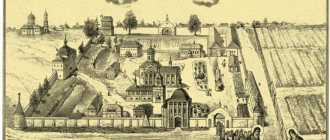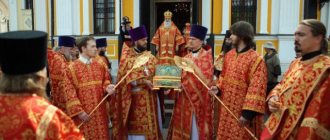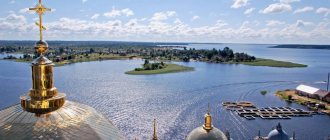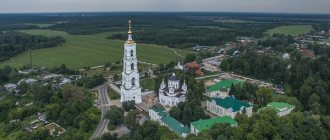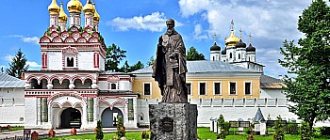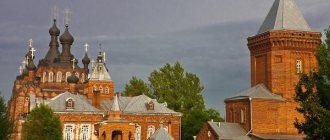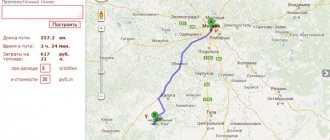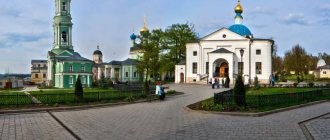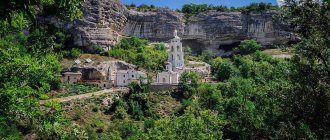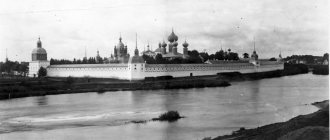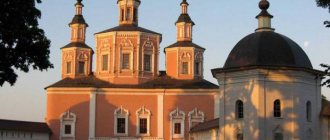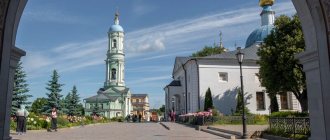| Trinity-Odigitrievsky Monastery of Zossimova Pustyn |
Moscow Trinity-Odigitrievsky stauropegial convent of Zosimova Monastery
of the Russian Orthodox Church
- Address: Russia, 108805, Moscow, Novofedorovskoye settlement, pos. Zosimova Pustyn
- Tel.
- Official site:
- On the map: Yandex.Map, Google map (no exact coordinates)
In 1826, near Moscow, on a plot of land in Vereisky district donated by the landowner Maria Semyonovna Bakhmeteva, Elder Zosima (Verkhovsky) with the blessing of Metropolitan Philaret of Moscow founded a women's community in honor of the Smolensk Icon of the Mother of God “Hodegetria”.
The community included the spiritual daughters of the elder - nuns who had previously been nuns of the St. Nicholas Monastery in Turinsk, Tobolsk province. In 1838, the Church of the Life-Giving Trinity was built over the grave of Elder Zosima (Verkhovsky).
In 1856, the women's community was transformed into a monastery. At that time, there were three churches on the territory of the monastery - the Church of the Life-Giving Trinity, the refectory Church of the Nativity of John the Baptist and the gateway in honor of the Hodegetria icon of the Mother of God.
Under Soviet rule, the monastery was abolished, but the nuns were not immediately evicted. Abbess Afanasia (Lepeshkina) was able to unofficially preserve the monastery for another ten years by registering the agricultural artel “Zosima Pustyn” with the land committee.
In 1929 the monastery was closed. Abbess Afanasia was arrested and exiled to Kazakhstan. A home for the disabled was placed on the territory of the monastery, and then a pioneer camp for the Moscow Metro. Many buildings were destroyed. A club was set up in the building of the Trinity Church. The bell tower was used as a water tower.
In 1999, the territory of the Zosimova Hermitage was returned to the Church as a courtyard of the Novodevichy Convent in Moscow.
On March 7, 2000, by decision of the Holy Synod, the metochion was transformed into the Trinity-Odigitrievskaya Zosima Hermitage [1].
In 2012, in connection with a change in the border between the city of Moscow and the Moscow region, the Trinity-Odigitrievskaya Zosimova Hermitage was transferred to the canonical subordination of the Patriarch of Moscow and All Rus' as the diocesan bishop of the city of Moscow.
How to get to the temple near the Zosimova Pustyn cemetery:
In public transport:
By metro: From the Salaryevo station, take bus No. 309 or a minibus with the same number, go 21 stops to “Rassudovo”, then take bus No. 868 - 4 stops to the “Village of Zosimova Pustyn” and walk 200 m to the temple.
How to get there by car:
From the Moscow Ring Road to Kievskoye Highway. After 39 km, near the village. Yakovlevskoye, exit to the left, to the villages of Kuznetsovo, Rudnevo, then to the right, to the village. Circles and villages Zosimova Hermitage, where there is a cemetery, monastery and temple.
Telephone
8.
You can order services at the church. Services for seriously ill patients include:
- unction;
- confession;
- Communion in the hospital or at home.
With the help of the city ritual service “Your Ritual”, when organizing a funeral, you can submit notes of repose, as well as order services and requirements:
- funeral service at home, funeral service in absentia;
- funeral service;
- forty
Prices for funerals in Moscow and the Moscow region
More details
In the Orthodox tradition, for burial you need:
Blanket (shroud), body cross, hand cross, head aureole, sheet with the text of a prayer of permission, eight-pointed gravestone cross.
Donations at funeral services - average amount
For a funeral service, as is customary, it is customary to make a feasible voluntary donation, the average amount of which is 2 – 5 thousand rubles.
Monk Zosima
Zosimova Pustyn is a women's monastery. It was founded by a monk, a descendant of a Russian noble family. In the world he was known as Zakhary Verkhovsky. This man was born in 1768. He was educated at home and entered military service at the age of 18. After the death of his father, Zachary became the heir to two villages.
In 1788, Verkhovsky retired, sold his estate and became a monk. In 1922 he founded a convent, where he spent only a few years. Soon a conflict arose between some novices and Zosima. The nuns accused him of embezzlement and schism. Zosima left, followed by his spiritual daughters. Together they founded the monastery, which today is known as Zosimova Hermitage.
Artistic postage stamps
Artistic postage stamps (commemorative) are issued for memorable dates and reflect the cultural and historical heritage, the main events of domestic and international life, the achievements of mankind in all fields of knowledge, the rich flora and fauna of our country. The circulation of art stamps is limited and additional printing is not done.
Due to their diversity and artistic value, commemorative postage stamps are becoming the main collection material for philatelists - postage stamp collectors.
Description of the Trinity-Odigitrievskaya Zosimova Hermitage
Temples and buildings: Trinity Cathedral, gate bell tower, monastery cells, service buildings, fence with turrets
Having passed many spiritual tests in the fall of 1825, Elder Zosima arrived in Moscow. M.S. Bakhmeteva, who hosted the elder’s nuns, placed part of her lands at their disposal for the construction of the monastery, the founding date of which can be considered November 21, 1826. In 1833, a single-domed Trinity Cathedral was erected over the grave of Zosima, expanded in 1855 by chapels and given eclectic forms. The red-brick gate bell tower in the pseudo-Russian style was completed in 1857 and began to play the role of the dominant feature of the ensemble. These two buildings and the brick wall with the corner towers have suffered the most from time. The service buildings, in contrast, are much better preserved. In the 30s the monastery was turned into a recreation center, and in 1999, desecrated and looted, it was returned to the church, and, despite all the difficulties, it is gradually being revived.
Founding of the monastery
In 1826, near Moscow, Zosima founded a women's community. He lived here until his death. Zosima gave his last strength to this monastery. For many years he looked for benefactors. It is worth saying that this man, even among the monks, was famous for his extraordinary desire for solitude. He spent his last years three miles from the monastery, where he built himself a small cell. He lived there for five days. And he spent Saturday and Sunday in the monastery. Zosima died in 1833.
Patronal holidays
Patronal holidays are considered:
- The Holy Trinity;
- Smolensk Icon of the Mother of God August 10;
- departure to the Lord of the founder Zosima on November 6;
- Memorial Day of St. Zosima of Solovetsky and Hieromartyr Simeon of Persia on April 30;
- glorification of Elder Zosima on July 23;
- Memorial Day of Mary of Egypt April 14;
- Council of New Martyrs and Confessors of Russia February 7.
Divine service in the Trinity-Odigitrievskaya Zosima Hermitage
Current state
In 2021, restoration of four objects located on the territory of the convent was carried out. Currently, projects are being drawn up for the repair of other buildings recognized as cultural heritage sites.
Cathedral of the Life-Giving Trinity in Zosima Hermitage
In the desert there is a vegetable garden, a chicken coop, a cowshed, and an apiary. The production of monastery baked goods and prosphora is being restored. The monastery helps a shelter for teenagers and disabled children. There are plans to open a Sunday school.
The monastery regularly holds lectures and organizes meetings with interesting people. In January of this year, a teacher at St. Tikhvin University conducted a lesson on the history of the Church Slavonic language. He also read the Bible on it.
On a note! All events and meetings are absolutely free, everyone can visit the monastery for free. Upcoming events are posted on the official page of the monastery.
In various years the nuns were the abbess of the monastery:
- Afanasia;
- Faith;
- Magdalene;
- Sofia;
- Elena.
Currently, the monastery is under the leadership of Sister Faina. The lives of two nuns are interesting - Athanasius. They ruled the desert in different centuries with an interval of 50 years. The first sister, due to leg disease in old age, could not walk; she was carried on a cart.
Activities of the monastery
The monastery conducts active preaching activities. The teachings are accompanied by the free distribution of special books that fully correspond to Christian teaching. You can learn about the current state of missionary work from theological materials.
Church of the Nativity of John the Baptist in Zosima Hermitage
Long services are held in the monastery, and on weekdays the rule of Seraphim of Sarov is read. On the territory of the monastery, icons are painted, books are bound, food is prepared, and clothes are sewn.
Since March 2021, the Zosimova Monastery Museum has opened on the territory of the monastery. It features three halls, covering different time periods - the end of the 17th century, 1897, Reverends Herman and Alexy.
Shrines
The martyr Tryphon is especially revered in the monastery. On Wednesdays, an akathist to this saint is read. Between the central and Zosima chapels there is a cast bronze hand with the relics of St. Zosima.
They thin out a special fragrance that changes - sometimes it is rich and obvious, sometimes it is barely perceptible. You can venerate the elder’s relics and ask him for help any day.
Interior of the Church of the Holy Trinity
The Smolensk Icon of the Mother of God gave rise to the name of the monastery. According to legend, the first image was painted by the apostle and evangelist Luke. “Hodegetria” translated into Russian means “guidebook”. It was with this icon that Zosima came to the Ulyanin hermitage, later called Zosimova.
